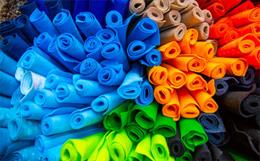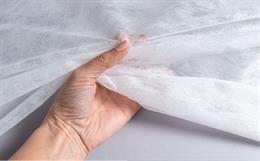Anumber of Priority Technology Development Needs have been identified fornonwoven manufacturers. These are described below:
Light-weightin nonwoven products
Light-weightin nonwoven products while maintaining or improving performance particularlyfor insulation and filtration products - is crucial to the future viability ofmany nonwoven manufacturing enterprises. Input material costs represent a highproportion of the final product cost and in many applications such asautomotive insulation there is a continued demand for a reduction in weight ofcomponent parts. The stress should, therefore, be on the use of finer fibres toincrease surface area for a given mass of fibres and to develop innovativestructures to improve performance without increasing mass.
HighSpecific strength nonwovens
TheHoly Grail in geotextiles is to increase strength/unit weight of fabric. Thisis particularly relevant where mining applications present severe challengesfor geotextiles because of the loads that mine infrastructures have to endure.Other applications for nonwovens such as filters for the mining industry andsome building products would also benefit from improved strength. The improvedstrength must be achieved without affecting other performance related propertiesof the fabric. Because of the high proportion of final product cost attributedto the input fibre the increase in strength must be achieved with no increasein material input. Therefore an important challenge is to find ways ofachieving this whilst also achieving equal strength in each direction of thefabric. To achieve these goals, some of the focus areas, therefore, will be :new web bonding techniques; innovative structures which provide higher strengthto weight ratios and incorporation of new high strength fibres.
Engineeringthe properties of nonwovens
Theabove mentioned two priority technology needs target specific fabriccharacteristics. More generally there is a need to be able to engineer theproperties of nonwoven products to better meet customer needs. Nonwovenproperties, in practice, are determined by empirical means at the factorylevel. The engineering of properties based on more rigorous processes couldlead to significant savings and improvements in nonwovens properties such as isotropicstrength, porosity, bulk etc.
Anisotropy of properties often means extra weight has to be used to achieve target strength in the weaker direction whereas isotropic strength would mean less material could be used. Bulk or low density of nonwovens m ns higher than necessary transport costs, ability to pack densely but have good recovery later would reduce transport costs as well as improve productivity both at manufacture and converting due to increased roll change intervals. Hence, the technological initiatives should be directed at:
- Investigating machinery settings and configurations which control key nonwovens properties.
- Developing relationships between machinery parameters and nonwovens properties.
- Developing new options for controlling web and final product properties through machinery and process control innovation.
High production rate micro and nanofibre processing
The larger surface area and finer pores that result from using finer fibres opens up new product opportunities where performance is determined by these properties of the nonwoven product. For example: applications in insulation, filtration, hygiene, healthcare, etc. However, production and processing rates decrease as the fibres become finer. If this nexus can be broken, it will open up the possibility of new high performance products which can be produced at commercial production rates. High production and processing of micro/nanofibre would require a technological exploration of:
- Melt blowing submicron fibres.
- High production rate electro spinning of nanofibres.
- New carding technology with higher production rates for processing micro-fibres.
- Splittable fibres processed by hyroentanglement or chemical
- Processing to produce microfibre nonwoven fabrics.
- Force spinning of nanofibres.
End use innovation
The nonwovens manufacturing suffers from short product runs which leads to low machine utilisation and therefore high production costs. There is a constant need to find new markets for existing products to increase the length of product runs. Many metal and plastic materials are being replaced by fibrous materials and there needs to be a concerted effort to find new applications for the products which are manufactured by this sector of the industry. This requires extensive survey relevant to the application of fibrous materials for the new emerging end use applications. The industry associations need to adapt cooperative approach to developing new end use markets for nonwoven materials.
Active nonwoven materials
Nonwovens are often highly engineered but commodity products with little differentiation between products supplied by different manufacturers.
The industry needs to add value by developing products which perform an additional "active" function. Examples include filter materials that can selectively remove target contaminants, products which can sense their own condition such as damage or strain in filter belts or geotextiles, healthcare products which can sense and react e.g. a wound dressing which can sense the onset of an infection and release appropriate drugs, nonwoven packaging which can sense and indicate food freshness etc.
Such smart nonwoven products - with active functions - will add value to the end user and can attract a premium in the marketplace. The required technological inputs will be embedding or attaching active molecules to fibres through chemical treatments; printing active materials onto fabric; embedding MEMS devices in nonwoven fabric; using conducting fibres in fabric and 3D structures for enhanced functionality etc.
New products from recycled fibres
There is increasing demand to reduce the amount of textile waste which goes to landfill and in the longer term hydrocarbon based fibres may become less available and more expensive. There are, however, large quantities of recycled fibres potentially available to be processed into nonwoven materials.
However, there are considerable challenges to be overcome before the use of recycled fibres can be an economic alternative to the use of virgin fibres. Recycled textiles are often a blend of different fibres which are difficult to separate and this places limits on end products that can be easily manufactured using recycled fibres. Also the processing of recycled textiles to liberate individual fibres can lead to reduced fibre length. As a result recycled fibres tend to be used in low value applications such as mattress ticking, packing materials and carpet underlays. If a profitable industry is to be established based around the use of recycled fibres higher value products must be developed which utilise this raw material. Investigation will be required in the areas such as:
- Developing high value products which use recycled fibres for applications in insulation, geotextiles, building products etc.
- Identifying single fibre type supply sources of recycled fibres.
- Developing effective fibre sorting techniques.
- Developing composite materials which utilise the benefits of fibre reinforcement
- Developing newer methods of chemically modifying recycled fibres to improve end product options.
Sustainability: Reduced waste, energy and water
There is a rapidly growing awareness that the next wave of industrial innovation will be based around sustainability.
Sustainability issues coupled with the need to reduce production costs gives rise to the challenge of reducing waste discharged to the environment as well as reducing energy, water and chemical usage in nonwovens manufacturing. It is also likely that we will see rising costs of electricity due to the implementation of some form of carbon emissions reduction scheme making it even more urgent to reduce energy inputs.
Initiatives required to achieve these goals are:
- Benchmark companies in industry to identify best practice.
- Investigate use of solar energy, smart electricity meters, waste heat recovery, water recycling and use of green chemicals.
- Study thoroughly the pattern of energy use in nonwoven processes and devise means to minimise it.
Knowledge management, process control and automation
The nonwovens sector of the textile industry is the most suited to the implementation of the process monitoring and control philosophies commonly used in other process and manufacturing industries. There is a clear opportunity to develop knowledge based process control techniques and automated systems to reduce costs and improve quality in nonwoven processes. The challenge is to identify and develop appropriate monitoring and control systems that add value, are reliable and can operate continuously in a nonwovens mill environment. An additional challenge is to develop automation and flexible systems which maximize machinery utilisation in a short run manufacturing environment.
- Benchmark within and outside of industry to identify opportunities for improved process control.
- Develop knowledge based models of nonwovens processes to provide a basis for control techniques.
- Develop cost effective on-line sensing techniques which will allow zero defect manufacturing.
- Identify opportunities for robotic handling of materials.
The Future of Nonwovens Industry
The reality is, as in most manufacturing sectors, there is unlikely to be a revolutionary change to the industry but rather a continuous evolution to meet market needs with competitively priced, high performing products.
It has been emphasized by manufacturers that the industry cannot take a technology push approach to its development. To be successful companies must take a disciplined market driven approach with the adoption of lean manufacturing principles. Therefore the technology developments described above must always be seen in the context of allowing manufacturers to better meet the needs of the market. If this can be achieved the nonwoven manufacturing industry can prosper and be seen as a successful, high tech advanced materials manufacturing sector.
There is no guarantee that the industry will be successful. Some rationalisation may occur in the future but most owners of nonwoven businesses need to be optimistic about the future.
Image Courtesy:
- Delu-china.com
This article was originally published in the November issue of the New Cloth Market: the Complete Textile Magazine from Textile Technologists.








